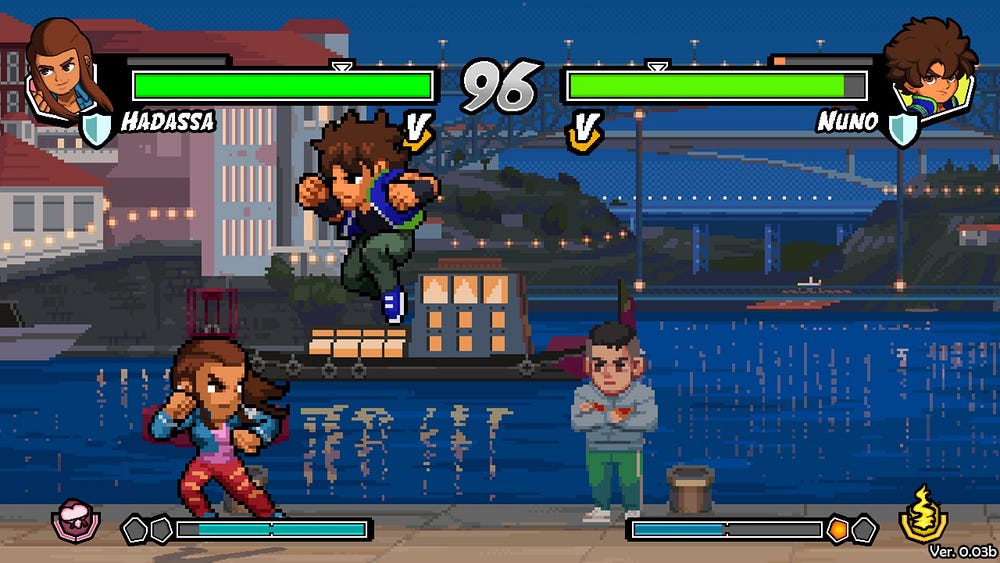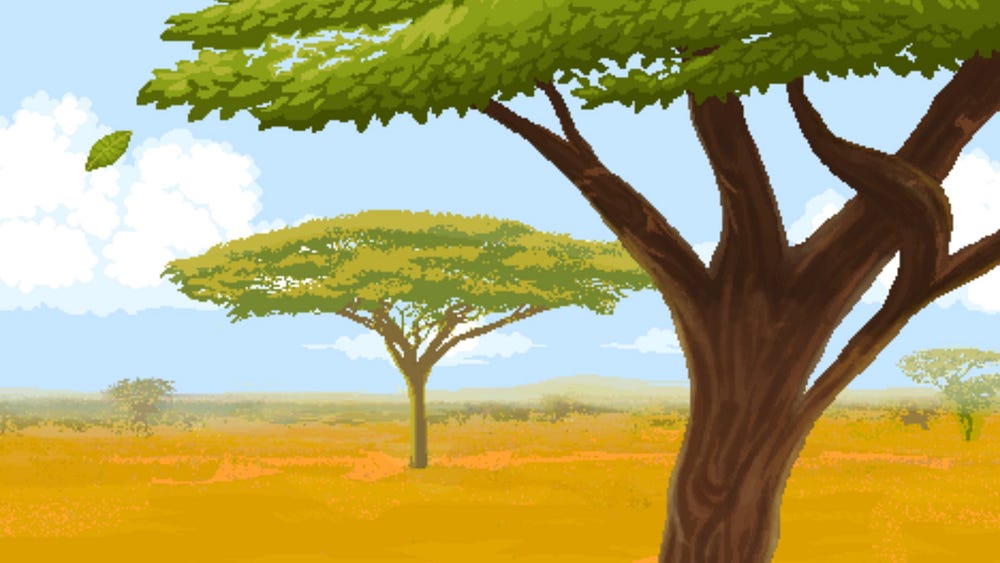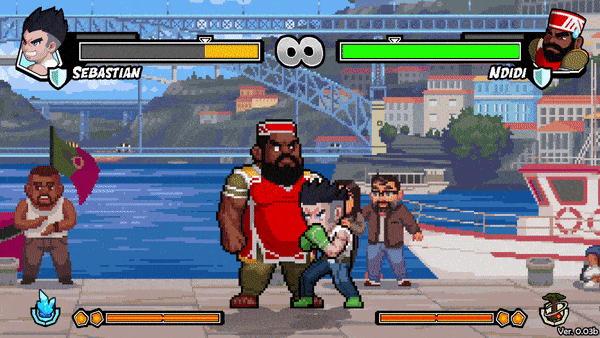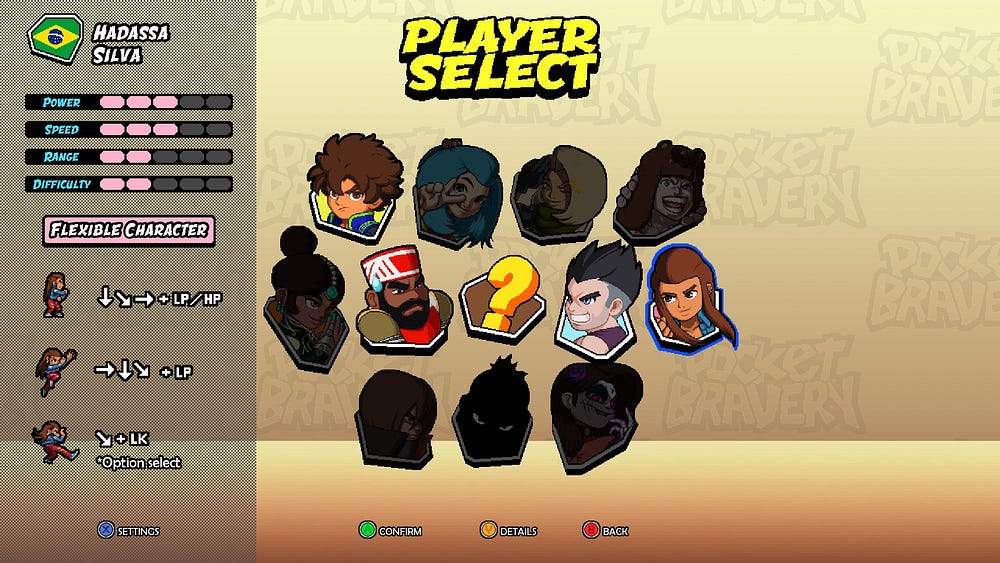This article is part of my ongoing “Indie Fighting Game Thursday” review/retrospective series, now on supercombo.gg! This week we talk about the demo of Pocket Bravery, a 2D traditional fighting game available on Steam!
I will be blunt: My backlog of indie fighting games to play and review is long and becomes longer by the day, so it can happen that some very promising titles get lost in a sea of solitude. Thus, I asked the SuperCombo community about which game they would have liked to see covered. One of the names that was suggested was Pocket Bravery, a game I had heard of, but never actually tried. While looking for it on Steam, I have found out that, while not having been released yet, it has a free demo currently available, so I’ve decided to give it a shot.
Oh, boy, I should have done it much, much sooner.

Let’s turn up the heat! Stages in Pocket Bravery change depending on the round. Porto, for example, moves from day to night and has a different set of NPCs for every round. Fun fact: the background character in the third round on the Porto stage is Beto/Roberto, a character from Ganbatte Karate — a 2D Fighter Maker 2002 game I have covered in this article on this very website!
Small size, huge heart
Pocket Bravery is an upcoming 2D pixel art fighting game developed by Statera Studio, an indie development team from Brazil. The game went through a rocky, ultimately unsuccessful Indiegogo campaign, but instead of giving up on it, the developers doubled down and decided to go on, against all the odds.
The game adopts a graphic style that can be seen as a compromise between the Neo Geo Pocket sprites and high resolution sprites, giving the characters a sort of “chibi” look.
The basic system relies on four dedicated buttons (Light Punch, Heavy Punch, Light Kick, Heavy Kick). Each character has access to some command normals and/or target combos and some buttons have also a “close” (i.e. proximity normal) version with different properties.
Special moves are performed by inputting a standard motion (fireball, dragon punch, half circle, 360) plus a button. Much as its main source of inspirations, Pocket Bravery is mostly link-based: Normal moves cannot normally cancel into each other, with the except of target combos, but must instead be linked together. However, normal moves can be canceled into command normals and both can be — with some exception — be canceled into special, EX and super moves.
Meterless combos are thus generally short — jumping normal into normal into command normal into special move. EX moves can be used as combo extenders, but the damage scaling is fairly brutal.
Grabs are performed by pressing Light Punch plus Light Kick together and can be teched by pressing the same input. Movement-wise, characters have access to backdashes, forward run and two types of jump (normal and long) which cover different distances.
There is a super gauge, which is used for super moves and can store up to three stocks. Each super uses up one stock, and is usually triggered by performing a more complex motion followed by one or two buttons pressed together. Special moves can be canceled into supers by spending half a bar more, increasing their cost but also the potential damage of a combo.
Notice that I haven’t said a lot about EX moves, for a reason: they have their own unique mechanics.

The fight is on in the docks of Porto!
Elemental gauge, baby!
Near the usual super meter, Pocket Bravery shows a secondary indicator with two stocks that use element symbols as icons. This gauge can be replenished like the usual super gauge, but represents a unique resource. Up to two elemental bars can be stocked at any time and can be used for a variety of effects.
Firstly, EX moves (here called Elemental Moves) consume one elemental stock and no super meter. They are usually powered up version of a character normal specials and are performed by inputting the same motion as the special plus two attack buttons (both punches or both kicks, depending on the move). Some Elemental Moves change the underlying special significantly and add some unique utility to them: Sebastian, for example, can use his quarter-circle-forward plus two punches to erect a wall of ice that will stop both your and your opponent’s movements and can be broken into a shower of short-range projectile by any of his attacks.
Canceling into EX moves from any other move — including specials — costs an additional half bar of super meter. This is referred in-game as Elemental Cancel.
The Elemental Gauge is also used for the so-called Breaker: A sort of defensive burst that is accessed by pressing Heavy Punch plus Heavy Kick while guarding or being hit by the opponent, essentially interrupting the opponent’s offence for the cost of one elemental stock.
Managing the Elemental Gauge and deciding how and when to use it is one of the most important skills to learn when mastering this game: A well placed Breaker or Elemental Move can be the difference between victory and loss.

Stage intros have some beautiful art and animations as a prelude to the fight.
Final Attacks and the pain that follows
When a character’s residual health falls under 30%, they gain access to one last resort: Final Attack, a desperation move that completely depletes a full Elemental gauge, doesn’t cost any super meter and — on hit — deals around 50% damage.
Whether this move connects with the opponent or not, the character who performs it loses access to the Elemental gauge for the rest of the round — much like a failed insta-kill disables the tension gauge in Guilty Gear.
Some of the Final Attacks, for example Sebastian’s, can be comboed into pretty easily, allowing for not wasting this precious resource in vain. Hadassa’s and Ndidi’s are more akin to command grabs and cannot be easily confirmed into —so, use them at your own risk: Having to play without the Elemental gauge locks one out of the most useful tools each character has, so losing access to it is a pretty huge deal, especially when one is already struggling with low health.

The combo damage is relatively low — well, at least until Final Attacks enter the fray.
For your shortcuts only
In order to improve its accessibility to more casual players, Pocket Bravery offers a set of four possible shortcuts buttons (mapped by default to the bumpers and triggers, when one plays on pad). The shortcut buttons can be assigned to several actions, like special moves, super moves, even Final Attacks, or macros like both punches and both kicks — but are not planned to be available in online modes.
When performing a move through a shortcut, a small icon with an arrow appears near the super gauge. Until this indicator is completely filled and disappears from the screen, no shortcut input will be accepted. The cooldown is of the order of a couple seconds and prevents players from spamming “easy specials”.
While this is a welcome feature, the global cooldown on all shortcuts makes it obnoxious to use them as more than combo fillers or for a raw punish, as one cannot string shortcut moves one after another — even when they are part of the same follow-up chain.
It is a nice quality-of-life feature, but I feel like having different cooldown for every shortcut might have served a better purpose.

Victory screens are very well drawn and remind a bit of the Art of Fighting days, where your pummeled, bruised opponent would stand defeated in the background.
A balanced cast for a balanced demo
The demo has four playable character: the fiery bruiser Nuno, using fire-based moves and some movements inspired by capoeira to fight as a solid beginner character; the Scottish rushdown boxer Sebastian, who instead makes use of ice and can erect frozen walls with his uppercuts, the Brazilian semi-grappler Hadassa, whose move set seems reminiscent of karate and Brazilian ju-jitsu, several command grabs and a strike grab with three follow-ups; the colossal Nigerian brawler Ndidi, who has a vast array of charge moves, a full screen earthquake, a sort of spinning piledriver, and is the most technically demanding character in the current demo.
In my play time, I have enjoyed Hadassa a lot for the flexibility she had. I have also noticed that no characters in the demo have a traditional full screen projectile: Nuno, the nearest thing this game has to a shoto, has a short range explosion in place of a more traditional Hadoken, while Ndidi, who seems to cover a niche between SF3 Urien and Hugo, has access to something akin to Sonic Booms that travel diagonally upwards instead of going straight.
The final version of Pocket Bravery is scheduled to have many additional characters and I can’t wait to see what else the developers are planning to add!

The character selection screen highlights general archetype and staple moves for all playable characters.
Details are everything
What is extremely impressive about this early demo, is the production value. The sprites, the stages, the animations, the music, the sound effects, the voice acting are all on point and of a quality that would be apt for a finished product.
Pocket Bravery is gorgeous in motion, and it knows it. Every stage has a special animated intro, characters have pre-match banter, there are subtle light effects and stage variations depending on the round, with different NPCs popping in and out. There are classic end-of-the-round victory cards too, with a pummeled rendition of the losing fighter in the background, as SNK used to do in the Art of Fighting series.
Speaking of SNK, pressing Back on the controller triggers a taunt, which can have different effects depending on the mood of the character you are facing, e.g. reducing their super meter by half a bar. If this doesn’t give you some KoF’98 vibes, it should. I have not understood yet how the mood is assigned to each character at the beginning of a fight (it might be matchup and stage dependent), but it has an actual — if limited — effect on the gameplay.
The soundtrack is inspired and atmospheric, my favorite song being the background music of the Nigerian village stage, and the hit effects pack a punch.
The game is completely dubbed in Portuguese, which might sound weird to those who are more accustomed to English or Japanese voice actors, but has its own, unquestionable charm.
A special mention must be made for the Final Attack animations, which are already nearly perfect and seal the deal as credible “match enders”.

Ndidi’s Final Attack is a joy for the eyes. Give a medal to this animator, now!
Woes of a prototype
Unfortunately, all that glitters is not gold. This demo of Pocket Bravery has some quirks that undermine a very solid package — nothing that cannot be fixed, but that can sour a bit the experience for newcomers and veteran players alike.
For starters, pressing both punch buttons (or both kick buttons) together while not performing a special does not default to any attack button, which means that your character won’t attack at all if you press two buttons in the same category together. Most games in this genre default to the strongest button (e.g. if one presses Light Punch and Heavy Punch together and no action requires both of them, Heavy Punch comes out instead), but Pocket Bravery simply does nothing with it.
The second issue is that the input buffer for normal moves feels very strict. Even target combos need some degree of timing lest you don’t want to get a totally unrelated attack and cancel windows for specials feel much shorter than in comparable games. There are no issues for inputting raw specials, but, for super moves, the timing to complete the full motion is less than forgiving, especially for new players who might not have a grasp on quarter circle back into quarter circle forward motions yet.
Lastly, there are some minor visual glitches, like the shadow effect in the Brazilian pool stage overlapping with the health bars and “darkening” them.
A fairly minor quip, but the AI might use some improvement. The AI characters jump around a lot and they usually don’t manage to string together interesting combos. However, for such an early demo, this is completely forgivable.
These issues do not break the game at all, but make it a slight bit harder/obnoxious to play in its current state.

That dark filter on the right side of the screen isn’t an issue with your monitor, but a graphical glitch that draws the shadow above the HUD of the game.
Rollback in the works
As I was writing this article, I have seen a clip on the developer’s Twitter account that announced the first steps in the directions of implementing rollback netcode, with an accompanying video showcasing the syncing process between two clients. This is great news for all those who weren’t sure if Pocket Bravery would have received proper online modes, as the goal seems now clear in this direction.
The first step was taken! In this video, we show the beginning of Rollback Netcode implementation. We're all excited to watch the amazing online matches to come.
Add to your Wishlist and play the Demo 🔛 https://t.co/p4OyxfWbco#BeBrave #indiegame #indie #pixelart #gamedev #FGC pic.twitter.com/5Rmz0RU4Bz
— Pocket Bravery (@PocketBravery) November 23, 2021
What’s in the package?
The current demo has a serviceable local versus mode with a fairly basic AI and a rather complete training mode with several options, including showing hitboxes and some basic frame data. The game is rather barebones, as expected, but has some welcome feature such as accessibility options for colorblind people, with more to come.

Training mode is already fairly complete, including some welcome options, like showing hitboxes, damage data, and various dummy settings.
How to play it?
The demo of Pocket Bravery for PC can be downloaded for free on Steam. The price and the release date for the finished version of the game has not been disclosed yet, but you can already wishlist it to support the developers.
Game summary
Name of the game: Pocket Bravery (Demo)
Developer: Statera Studio (developer’s website, game’s Twitter account)
Available on: PC (Steam)
Price: Free (demo), TBA (full version)
Year of release: 2021 (demo), TBA (full version)
Engine: Unity
Netcode: None (demo), rollback netcode (full version)
Status: Demo — version tested: Demo version 0.03b
In one sentence: A 2D “chibi” traditional fighting game that draws inspiration from classic SNK games, will have rollback netcode, and has already incredibly high production values, despite still being available only as a demo.
Special thanks to the SuperCombo users Shreeder4092 and EinAston for suggesting me this game in the forums.
If you are interested in more coverage about indie fighting games, you can find me on Twitter at @AndreaDProjects

